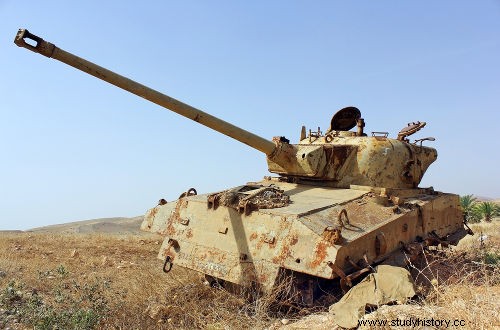
What was the Six Day War ?
The Six Day War , or Third Arab-Israeli War , was fought between June 5 and 10, 1967, with the armed forces of the State of Israel on one side and those of Egypt, Syria, Jordan and Iraq on the other, which, in turn, received the support from Kuwait, Libya, Saudi Arabia, Algeria and Sudan. This was the quickest war fought between Arabs and Israelis and it was also the war that made it possible for Israel to expand its territory, conquering the Sinai Peninsula, the West Bank, Gaza, East Jerusalem and the Golan Heights – which subsequently triggered the Yom Kippur War , in 1973.
The reasons for the conflict
Arabs and Israelis had already clashed twice since the Independence of the State of Israel , in 1948. In the 1950s and 1960s, Arab nationalism was on the rise, led by the President of Egypt and later President of the United Arab Republic (RAU), Gamal Abdel Nasser. Abdel Nasser was supported byHafez al-Assad , of Syria, by King Hussein , Jordan, and other Arab heads of state, especially those who were part of the Arab League . At the Second Cairo Conference 1964, these countries made it clear, through a declaration, that one of their main objectives was the destruction of the State of Israel .
This type of stance has greatly increased tension in the Middle East region. The situation worsened when Syria and Jordan started to support guerrilla groups born from the Palestine Liberation Organization, the PLO , and to move regular troops along the borders with Israel, in May 1967. Pressured by Syrians and Jordanians, Gamal Abdel Nasser mobilized Egyptian troops in the Sinai Peninsula, on May 16, and ordered UN troops - present in the place since the end of the last Arab-Israeli war (1956) – withdraw. On the 22nd of the same month, Nasser ordered the blockade of the Gulf of Aqaba . On June 4, Iraq joined the Jordanian-Egyptian mutual aid pact in the event of war. Anticipating a coordinated attack by these countries, the next day, Israel began its “blitzkrieg”.
Lightning War
On the first day of the war, 309 of the 340 Egyptian fighter planes were destroyed by Israeli fighter jets in the space of just two hours. The planes were destroyed at their military bases on the ground. On the second day, Israel crossed the borders of the Sinai Peninsula. On the third day, Israeli paratroopers conquered the Old City of Jerusalem , which was under Jordanian rule, and still on the 7th they reached the strait of Tiran and on the 8th, Rumani , near the Suez Canal . In the following days, Egypt and Syria were already defeated, and the war continued against Jordan. With the advance of Israeli troops on the border, there was the capture of the West Bank - Jordanian portion close to the natural border of the Jordan River.
The balance of the war was as follows:for Israel, the calculated damage was 980 soldiers killed, 4,520 wounded, 40 planes shot down and 394 tanks damaged. On the Arab side, 4,300 soldiers were killed, 6,120 wounded, 444 planes shot down and 965 tanks damaged.
Consequences
The very dynamics of the development of the war favored Israel in the occupation of neighboring territories, it is worth noting, therefore, that such occupation was not planned nor had a definitive character. As sociologist Cláudio Camargo explains, the Six-Day War:
was a conflict that neither side wanted and which, contrary to what it may seem, lacked political and strategic planning on the part of Israel, although many Arab analysts believed that the conflict was deliberately provoked by the Israelis to expand their territory. However, the conquest and occupation of the West Bank and the Golan Heights were defined over the course of the battles and were not in the initial plans of Israeli strategists. [1]
This can be proved by the fact that on June 19, 1967:
[…] the Israeli cabinet met and decided to propose a peace agreement with Egypt and Syria, withdrawing its troops from the occupied areas since freedom of navigation in the Straits of Tiran and the Suez Canal were guaranteed:the demilitarization of the Sinai Peninsula and the Golan colonies and the non-interference in the flow of water from the sources of the Jordan River. Regarding the West Bank – which at the time already had a population of 1.2 million Palestinians – the cabinet was divided between the option of granting autonomy to the Palestinians, but keeping the territory under Israeli control or returning part of them to Jordan. [2]
NOTES
[1] CAMARGO, Claudio. “Arab-Israeli Wars”. In:MAGNOLI, Demetrius. History of the Wars . São Paulo:Context, 2013. p. 441-42.
[2] Ibid . P. 442.
By me. Claudio Fernandes
Take the opportunity to check out our video lesson related to the subject:
